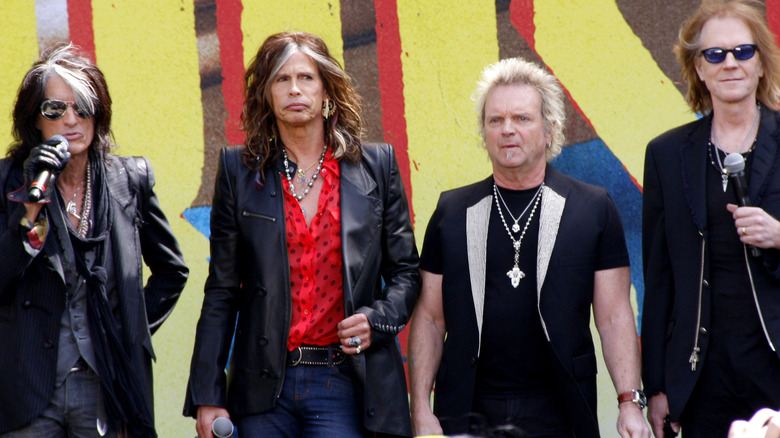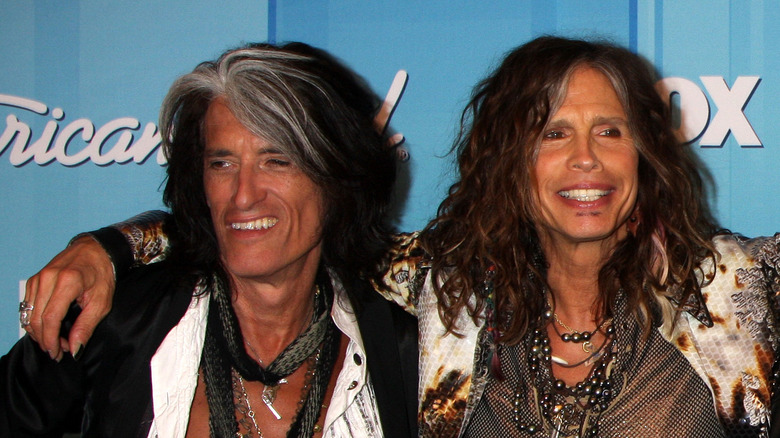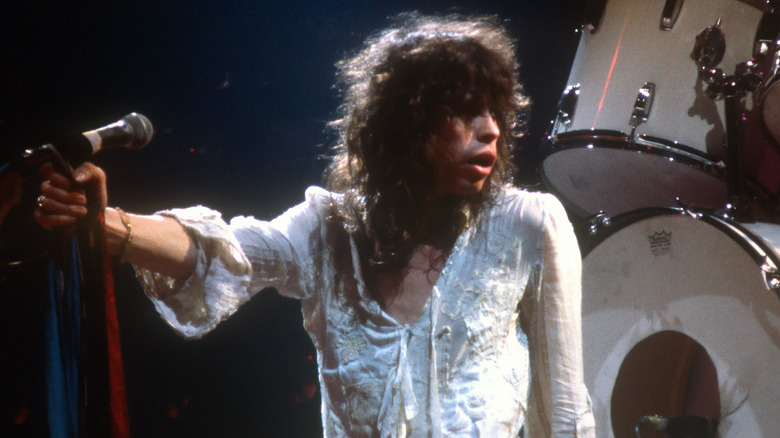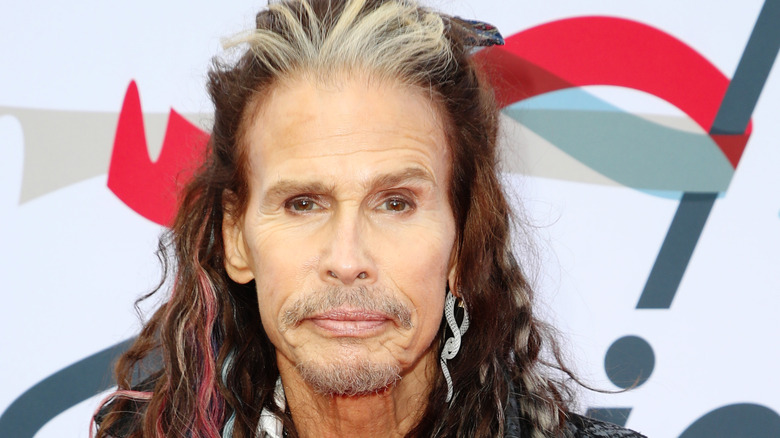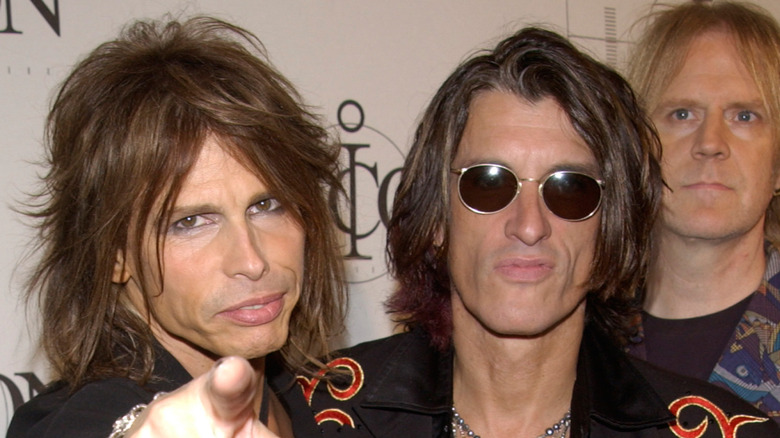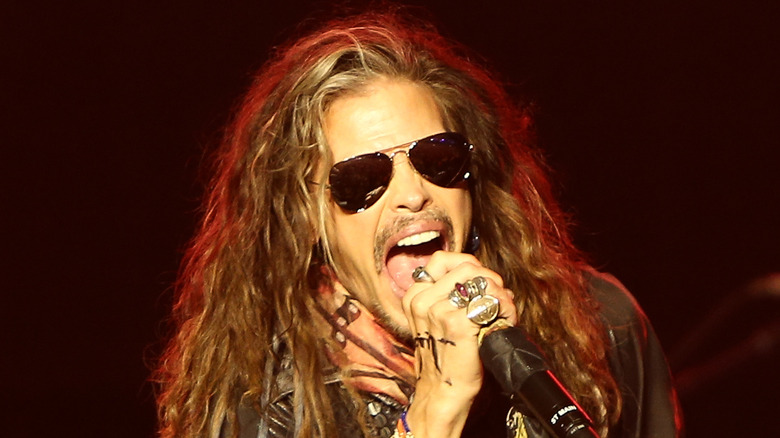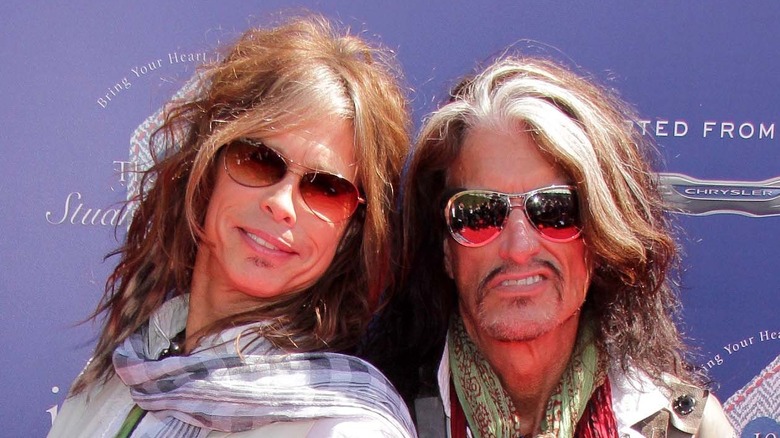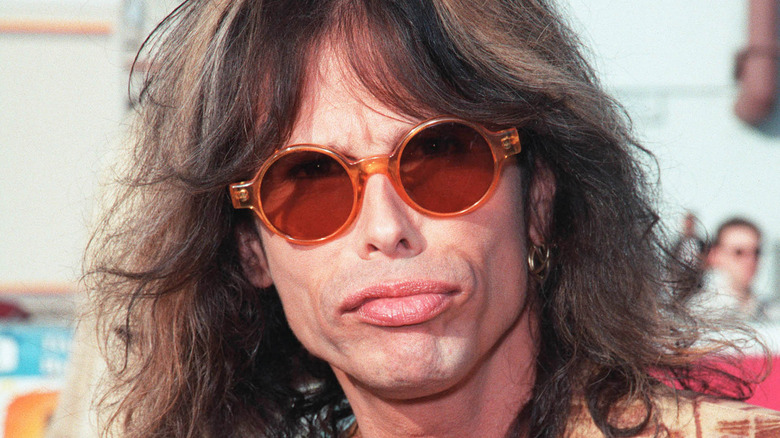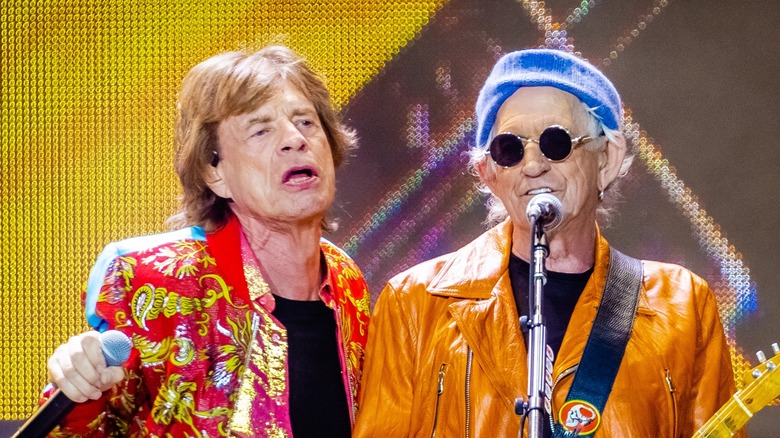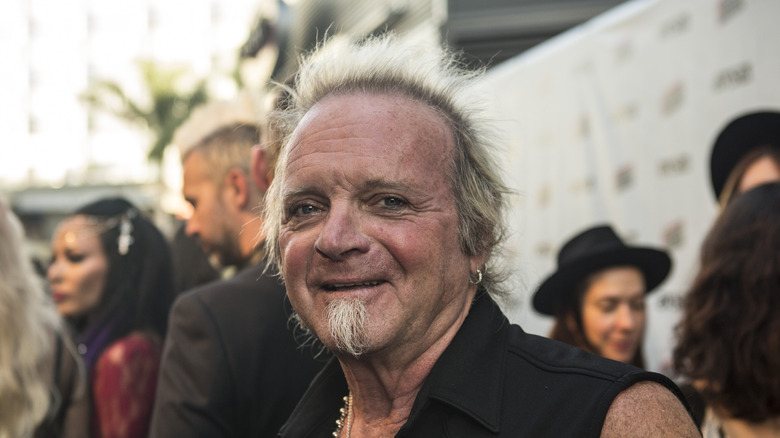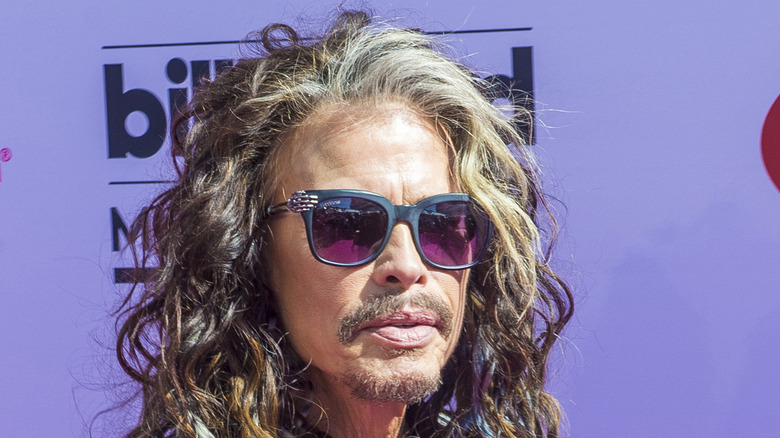The Untold Truth Of Aerosmith
Few rock bands have had such high highs and low lows as Aerosmith. As Rolling Stone reports, Aerosmith have been around since 1970, which makes them one of the longest-standing rock 'n' roll bands of all time. But their journey has been nothing short of a rollercoaster filled with feuds, drugs, and backstage drama.
Nevertheless, without darkness, there is no light — Aerosmith's dramatic downfall paved the way to a glorious comeback. Today, according to Loudwire, Aerosmith are the seventh best-selling rock and metal band of all time. But there's more to them than facts and numbers. As Steven Tyler wrote in his 2004 memoir, "Does the Noise in My Head Bother You?": "It's hard to tell who I am by the trail left by my musical career. I am the Demon of Screamin', the dude that looks like a lady, the rag doll that married Lucy in the Sky. But I'm also something more than the rock n' roll junky ... who got his foot inside the door." So let's explore the untold truth of Aerosmith.
It all started with Jeff Beck
As Britannica reports, Jeff Beck made a sensation as early as 1965, when he replaced Eric Clapton as the Yardbirds' guitarist. By the beginning of the following decade, he'd also founded his own band, the Jeff Beck Group, with Rod Stewart on vocals and Ron Wood (who would become a vital part of the Rolling Stones) on bass. But in 1970, both Stewart and Wood left, and Beck began looking for new bandmates.
Enter Steven Tyler. As Rolling Stone reports, it was 1970 when Tyler first got Joe Perry, Tom Hamilton, and Joey Kramer together in one room. Tyler's initial plan was simple: The other three were supposed to help him make an audition tape for the Jeff Beck Group. But once they started playing together, magic happened — or at least, the four musicians became really pleased at their sound as a group. Soon enough, they chose a name for their band and released an album. So, while Jeff Beck was at the core of Aerosmith, he never received the audition tape.
Steven Tyler and Joe Perry's lifelong feud
As Steven Tyler wrote in his memoir, "Does the Noise in My Head Bother You?," Joe Perry lived six miles away from his family's holiday ranch in Sunapee, New Hampshire, but the two didn't really come together until their teenage years, when they got into music, and Perry invited Tyler to see him play. You'd be excused for thinking they're like twin brothers: They've known each other for a lifetime, they had the same dream, and they're in the same band. But, as Aerosmith found fame, Tyler and Perry found several reasons to hate each other — drugs and diverging views being at the top of the list. As per NME, the pair became known as the "Toxic Twins" in part for their continuous friction.
Brad Whitford remembers on 60 Minutes Australia: "For a long time, when I was first in this band ... after the show was over, I used to grab my bag [and] I would leave ... I did not want to be in the dressing room. There was stuff flying." Tyler and Perry seemed to patch things up in their later years. But when Tyler announced he would be a judge on the 2012 edition of American Idol, Perry berated him for it: "It's one step above Teenage Mutant Ninja Turtles. I'll tell you one thing, when we put this band together, this is not something that he would do. It's his business, but I don't want Aerosmith's name involved with it" (via Rolling Stone).
The 1980s decline
Steven Tyler confessed to taking an enormous amount of drugs in his autobiography, "Does the Noise in My Head Bother You?." He also pointed to the consequences: "Drugs will steal you like a crook. Spirituality, over. I could no longer see the things I used to see in my peripheral vision." Throughout the 1970s, Aerosmith's fame escalated, but so did the band's substance abuse. This affected their health, creative energy, and disposition to collaborate peacefully. As Ultimate Classic Rock reports, the band reached a breaking point when Joe Perry left the band in July 1979.
The first half of the 1980s was marked by a steep decline for the band. The decline was both financial (the band resorted to smaller venues) and mental, as per UCR, as Tyler himself described a very low point in the 1997 Aerosmith biography, "Walk this Way": "I dropped down and faked passing out. I'm so good at it, I even shook my foot so it looked bad." Tyler did so in 1980 because he just didn't care enough to continue the show. The same year, he almost lost his life in a motorbike crash.
Four years, one failed album, and dozens of terrible shows later, Perry came back to Aerosmith, and the band slowly got back on track.
If you or anyone you know is struggling with addiction issues, help is available. Visit the Substance Abuse and Mental Health Services Administration website or contact SAMHSA's National Helpline at 1-800-662-HELP (4357).
There were a lot of drugs
In his 2004 memoir, Steven Tyler remembers becoming fascinated with drugs as he started associating them with the music he loved. He said that he figured drugs must be the cause for talent — like Pete Townshend of The Who, whose use of speed caused his stutter in "My Generation." As Tyler became a singer himself, he started experimenting — but he did so very early on, around age 16, before he was even legally allowed to drink. "So all we could do was grass and pills ... I'd go up to Sunapee [and] snort speed until I was vibrating at the same frequency as the ... records," he said.
Tyler's obsession with drugs was matched by every member of Aerosmith, as Tyler told Haute Living, "We all became very f****d up. There were no such things as rehabs; there were mental institutions. ... The early '80s were terrible, and drugs took us down." He'd already been to rehab in '84 and '86. In 1988, the band did an intervention and sent Tyler to rehab. This was the start of a new era for Aerosmith — an era of rock for the sake of rock and nothing else.
If you or anyone you know is struggling with addiction issues, help is available. Visit the Substance Abuse and Mental Health Services Administration website or contact SAMHSA's National Helpline at 1-800-662-HELP (4357).
The Barn
As per VH1's "Behind the Music" Aerosmith documentary, the band's origins lie in a rustic music venue in Sunapee called the Barn. This is where 18-year-old Steven Tyler would play, and the slightly younger Joe Perry and Tom Hamilton listened, fascinated by Tyler's band: "Any time when Steven's coming with his band, everybody's like, 'Wow, that's a big event.' The first couple of years, Joe and I couldn't even go in 'cause we were too young to get in the Barn. So we would sit outside and listen," said Hamilton. By 1969, Perry and Hamilton were playing at the Barn, too, but in a different band, the Jam Band (via "Does the Noise in My Head Bother You?," by Steven Tyler). That year, Perry invited Tyler to see him play at the same venue they'd seen him several times.
Tyler remembers a terrible initial impression: "Joe couldn't carry a tune to save his life ... They were out of tune, out of time." Then, Perry started his guitar solo and Tyler did a 180, completely mesermized and thunderstruck by Perry's skills. The Barn thus became the place where Tyler, Perry, and Hamilton realized how good they were, albeit at different stages in their early musical career.
Steven Tyler wrote Dream On at 17
Indeed, one of the most powerful rock ballads of all time was written by a teenager. Steven Tyler describes the moment of inspiration in this VH1 Aerosmith documentary: "One night when it was really dark and the summer was over and I was feeling really lonely, I sat down right in that house and I wrote this melody." Tyler attributes his inspiration (and "Dream On" chordage) to his father, who was a professional piano player and filled the house with songs by Debussy, Chopin, and Bach (via his memoir, "Does the Noise in My Head Bother You?").
"Dream On" became the first song on Aerosmith's self-titled debut album in 1973. But although the ballad is one of the most popular Aerosmith songs today, it wasn't an immediate success — in fact, the "Aerosmith" album sold under 100,000 copies following its release. As per Rolling Stone, "Dream On" did become a hit in 1975, after the single was rereleased.
The break-up and the reunion
In July 1979, as per Steven Tyler's 2004 memoir, the band's break-up started with a fight between the wives of Tom Hamilton and Joe Perry and ended with Tyler firing Perry. The latter was happy to leave. As he confessed (via Ultimate Classic Rock), Perry was disheartened by the lack of creative freshness and the ever-growing tensions within the band. Within two years, Brad Whitford left the band as well and started a new band with musician Derek St. Holmes. Aerosmith's success plummeted as a result of this break-up: On the one hand, fans were booing at their concerts, asking where Perry was,as per VH1's "Behind the Music." On the other hand, Tyler himself missed Perry and succumbed to drugs worse than ever before.
But Perry and Whitford didn't do so well, either. In fact, Perry remembers his solo project completely failing: "There was a short time in there when I had no band, no recording contract, no management" (via Ultimate Classic Rock). So on February 14, 1984, Perry and Whitford surprised Tyler backstage after a show (via UCR). That month, Aerosmith reunited, and Tyler and Perry started patching up their friendship. Around the same time, Tyler started going to rehab, and this helped them write more, tour more, and top the charts once more. This was the beginning of Aerosmith's second act, one which has yet to end.
There's a forgotten founding member
As per VH1's "Behind the Music" Aerosmith documentary, there's an Aerosmith founding member who often gets left out of the chronicles: guitarist Ray Tabano. Back in 1970, when Steven Tyler gathered his musician friends for what would become Aerosmith, he brought two guitarists: Joe Perry and Tabano. But Tyler explains why the connection didn't work out: "He joined the band, and he was such a wise-ass and such a tough guy, he pissed everybody off."
From Tabano's point of view, it was a different story, as he told Goldmine Magazine the usual Aerosmith rehearsals were marked by Tyler's constant dissatisfaction with his playing. According to Joe Perry though, Tabano simply wasn't a serious musician at the time: "A lot of times, Raymond would be late for rehearsal. Of course then, when he would show up, he would try to take over." Within a year, the band decided to replace him. Soon enough, they found Brad Whitford, who is still the band's rhythm guitarist. Tabano later commented to Goldmine Magazine, "If I was supposed to be in the band, I'd be in the band. I guess I'm not supposed to be in the band."
The shows (and shoes) really damaged Steven Tyler's feet
Apart from his incredible voice, Steven Tyler is also known for his eccentric fashion style. This includes the shoes he wore on stage while frantically dancing for decades on end. As he confessed to Oprah in 2012, these shoes slowly destroyed his feet: "My toes are all squished. During an operation, they had to take nerves out." Tyler had the operation in 2002-2003. But even following the operation (or perhaps because of the operation), Tyler has been struggling with intense pain in his feet. He recalls one time when he once again succumbed to drugs, only this time it was prescription painkillers and sleeping pills.
Needless to say, Tyler pulled through, but he will have to manage the pain for the rest of his life. As per Billboard (via NBC News), Tyler's condition is called Morton's neuroma. It happens when toe nerves get trapped under the ligament. It's probably safe to say fans will be seeing Tyler play in comfortable shoes going forward.
Aerosmith hate the Rolling Stones comparison
For a long time, Aerosmith have been compared to the Rolling Stones, but if you ask Steven Tyler, it happened for all the wrong reasons. As he wrote in his autobiography, "Does the Noise in My Head Bother You?," he was only 16 when someone noticed he looked just like Mick Jagger. Then, he started impersonating Jagger's imaginary brother, Chris. Of course, this was just a short phase, but critics and fans continued to make the comparison for decades after. Tyler told Rolling Stone, "Still, the 'Cheap imitation of the Rolling Stones' criticism was constant ... That I copied him, and Janis Joplin too. Mick was the cheapest, easiest shot. 'Well, he looks like him, so let's write about that.'" In Tyler's opinion, the comparison only happens because he and Jagger are look-alikes.
Joe Perry seconds Tyler's opinion that the comparison is unwarranted: "You could tell that they weren't listening, because we definitely weren't sounding like the Stones." They both admit that the Rolling Stones came before them and that their raw, rock 'n' roll interpretation of the blues inspired them. But for them, this is where it ends — Aerosmith is its own band, and they were never copycats.
The Arrowsmith theory is fake
There's a theory — exemplified by Rolling Stone – that Aerosmith derived their name from Sinclair Lewis' classic novel, "Arrowsmith." But, back in 1990, Steven Tyler told Rolling Stone that the theory simply wasn't true. Apparently, Aerosmith credit drummer Joey Kramer for their catchy name. Kramer remembers scribbling this name all over his books in high school. He didn't know what it meant, but he thought it sounded great, especially as the name of a rock band.
In 2019, Kramer gave Uncle Joe Benson on Ultimate Classic Rock Nights (via UCR) more details about his inspiration: "I was listening to an album at the time, by Harry Nilsson, called 'Aerial Ballet' ... We started kicking around this work 'aerial,' and 'aerial' eventually came into 'aero' — I don't know how that happened ... And it was like Aeromind, Aerostar, Aero-this, Aero-that; and somebody said 'smith' – Aerosmith? Wow!" From that moment on, Kramer knew "Aerosmith" sounded great, and he was also confident he would be in a rock band someday. He remembers telling lots of people about his plans and getting the same reaction: "Oh, that's very nice, Joey." Now, Kramer gets to associate their disbelief with the moment he started believing in himself and the moment he created a name that resounds in millions of ears.
Today, Steven Tyler wants to help others
Steven Tyler is famously sober now — as he told Oprah back in 2012, he is surprised and grateful to be alive after all the excess that he's not proud of. But Tyler also spoke to Howard Stern about sobriety in 2016 and revealed he is now working as a patient advocate to help others quit drugs: "They'll call me up, just kind of like, 'Oh, we have a runner.' And they'll just say, 'Look, I can get Steven on the phone.'" Tyler thus speaks to the patients directly and asks them what drugs they took and how they ended up abusing drugs in the first place. After he listens to their story, Tyler has a few encouraging words for them: "It doesn't matter. I did the same thing, but I'm out the rabbit hole."
Tyler's philanthropy doesn't end here. As per Haute Living, he set up Janie's Fund (a play on the Aerosmith song, "Janie's Got a Gun") in 2015, a foundation dedicated to the support of young abused women. As of 2022, there are two Janie's Houses, too, providing safe housing and intensive therapy for young girls.
